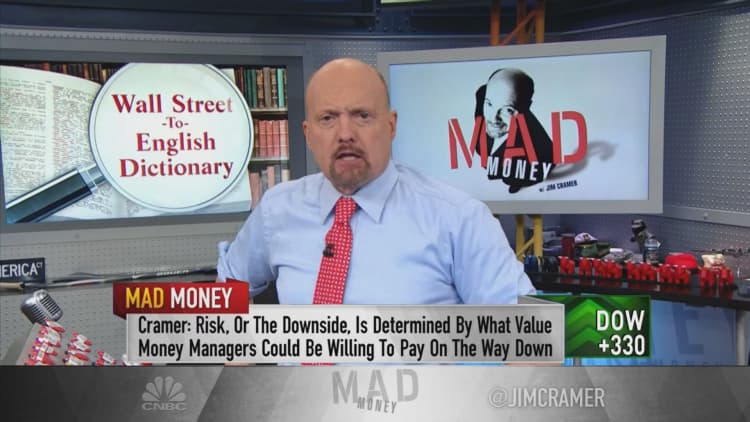
One of the biggest errors an investor can make when buying a stock is to project how high its share price can rise without considering how low it can fall.
Pain from a big loss hurts much more than the pleasure from a big rally, which explains why investors must determine a security's risk-reward when managing a portfolio, CNBC's Jim Cramer said.
"Know what you own and know what others will pay for it," the "Mad Money" host said. "That means you need to understand the risk-reward, the potential downside and potential upside, before you purchase anything, by figuring out where the growth investors put in the ceiling and where the value cohort creates the floor."
The reward, or upside, is a stock's potential ceiling, or peak. The ceiling is the amount growth-oriented big fund investors are willing to pay up for a stock. The risk, or downside, is the stock's potential floor, or bottom — what value-oriented money managers are willing to pay for a stock on the way down, Cramer explained.
"To figure out the risk, you need to consider where the value guys might start buying on the way down," he said. "To solve for the reward, you have to think about where even the most bullish of growth guys will start their selling."
A helpful tool is knowing GARP, an acronym that stands for "growth at a reasonable price" popularized by legendary money manager Peter Lynch, the host noted. The measure can be found by comparing a stock's growth rate to the price-to-earnings multiple, which is how much investors are willing to pay up for a share of the underlying company's earnings. GARP reveals the maximum that growth-focused investors are willing to pay for the stock.
Cramer has one "quick and dirty rule of thumb" to determine if a stock is overvalued or undervalued and game the institutional investors: A stock with an earnings multiple that's below its growth rate, with some exceptions, can typically be deemed cheap, while a stock with an earnings multiple more than two times its growth rate is usually worth selling.
"In other words, if something's trading at, say, 20 times earnings and … the company has a 10% growth rate, then it's likely at or near its peak because it's reached the two-times growth ceiling that I regard as a safety zone," he said.

Questions for Cramer?
Call Cramer: 1-800-743-CNBC
Want to take a deep dive into Cramer's world? Hit him up!
Mad Money Twitter - Jim Cramer Twitter - Facebook - Instagram
Questions, comments, suggestions for the "Mad Money" website? madcap@cnbc.com



